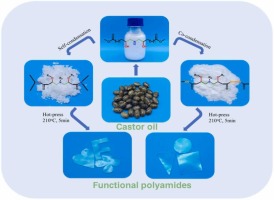The synthesis of polymeric materials from natural resources has become a global focus, due to the shortage of fossil fuels and widely concerned environmental issues (Cywar et al., 2021; Ding et al., 2023; Ganewatta et al., 2021; Wang et al., 2020). As a kind of abundant, easily obtainable, and renewable small molecular natural resources, plant oil has been widely used in oleochemical industry. During recent years, the synthesis of various polymers such as epoxy resin (Liu et al., 2022; Mu et al., 2020; Zhou et al., 2019), polyurethanes (Wu et al., 2023), and polyamides (Gao et al., 2023; Ma et al., 2022; Song et al., 2019) from plant oils has been intensively studied. Among them, PA11 is a highly successful example of long-chain polyamide (PA) derived from plant oil. It has been widely used in automobile, electronics and other fields (Meier, 2019). Compared with traditional short-chain PAs, PA11 possess better flexibility, dimension stability, and impact resistance. However, annual production of PA11 is limited by the complex monomer synthesis process (Nie et al., 2015). Moreover, PAs usually lack of functional side groups, thus the properties and functionalities of PAs are difficult to control. In view of the important value and broad application of long-chain polyamides, the existing monomers are far from meeting the market demand. Therefore, the development of functional monomers from plant oil is a major challenge in the preparation of long-chain polyamides.
The long alkane segments endow long-chain polyamides with properties superior to short-chain polyamides. Long-chain polyamides are mainly prepared by condensation polymerization, ring opening polymerization, and acyclic diene metathesis (ADMET) polymerization (Cui et al., 2005; Ehrenstein et al., 2003; Mutlu and Meier, 2009; Stempfle et al., 2016). During recent years, long-chain monomer synthesis has been intensively studied. In addition to traditional chemical conversion, many new methods have gradually emerged. Olefin metathesis provides a method for the synthesis of long-chain α, ω-bifunctional monomers from plant oil (Gonzalez-de-Castro et al., 2017; Kajetanowicz et al., 2019; Le et al., 2018; Nascimento et al., 2019; Ohlmann et al., 2012; Wyrebek et al., 2018). In our previous work, α, ω-bifunctional monomer and high-performance unsaturated polyamides were successfully prepared from woody oils (Gao et al., 2023). It is worth to note that plenty of by-products formed via double bond isomerization and cross-metathesis, which lead to low atom economy. Isomerizing alkoxycarbonylation has relatively high yield and atom economy. However, it is usually relied on expensive catalysts, and the reaction conditions are harsh (Goldbach et al., 2016; Jiménez-Rodriguez et al., 2005; Quinzler and Mecking, 2010; Stempfle et al., 2016; Walther et al., 2011). The existing preparation methods still suffer problems such as multi-step reaction, harsh conditions, high costs. Up to now, most long-chain α, ω-bifunctional monomers are still lack of functional side groups. Long-chain functional monomers are rarely reported and difficult to synthesis, which hindered the development of long-chain functional polyamides.
Over all, the design and synthesis of long-chain α, ω-functional monomer plays important role in the development of long-chain functional polyamides and high value-added materials. Castor oil and its derivatives, such as sebacic acid, 11-aminoundecanoic acid, etc., are typical platform compounds, which are widely used in the synthesis of polyamides (Naughton, Bayonne, 1974; Genas, 1962; Van der Steen and Stevens, 2009). Previously we reported a series of long-chain α, ω-diene functional monomers derived from castor oil. Long-chain functional polyamides were then prepared through thiol-ene addition polymerization. The aggregation structure was controlled by different side groups to obtain super strong polyamide elastomer (Song et al., 2019). However, the terminal carbon-carbon double bond of these functional monomers limited the polymerization method and real applications. Based on the hypothesis that side active groups can help better regulate polymer properties. Herein, a novel long-chain multi-functional monomer with ester, hydroxyl, and secondary amine active groups was synthesized from methyl 10-undecenoate via ammonia ring opening of epoxides. Based on this multi-functional monomer, a series of functional polyamides with different properties were prepared through melt condensation polymerization. The thermodynamic and mechanical properties of the prepared functional polymers were intensively studied.




